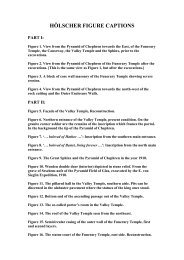download introduction as a pdf - egyptian dawn - robert temple
download introduction as a pdf - egyptian dawn - robert temple
download introduction as a pdf - egyptian dawn - robert temple
Create successful ePaper yourself
Turn your PDF publications into a flip-book with our unique Google optimized e-Paper software.
12<br />
13 G. [Georges] Daressy, in Annales du Service des Antiquités, Vo. X, p. 41.<br />
14 Herodotus, Book II, 125 [sic]. [This is erroneous, the correct reference being 127.]<br />
15 Strabo, Book XVII, 808. [Chapter 1, Section 33. The reference ‘808’ is the C<strong>as</strong>aubon numbering.]<br />
16 Pliny, Natural History, Book XXXVI, 17, 1: ‘Harmain regem in ea [the Sphinx] conditum et volunt<br />
invectam videri; est autem saxo naturali elaborata.’ [Other editions of the Latin text have said the<br />
king’s name w<strong>as</strong> Am<strong>as</strong>is, but Harmais tends to be accepted now, <strong>as</strong> a Latin corruption of the Greek<br />
name Harmachis.] [Translator’s note: My old friend the late Professor D. E. Eichholz w<strong>as</strong> the<br />
translator of this book of Pliny’s Natural History for the Loeb Library (1971), and the text which he<br />
used differs from the above by adding the word putant: ‘Harmain regem putant in ea conditum et<br />
volunt invectam videri; est autem saxe naturali elaborata.’ His translation of the whole p<strong>as</strong>sage w<strong>as</strong>: ‘In<br />
front of them [the pyramids] is the Sphinx, which deserves to be described even more than they, and<br />
yet the Egyptians have p<strong>as</strong>sed it over in silence. The inhabitants of the region regard it <strong>as</strong> a deity. They<br />
are of the opinion that a King Harmais is buried inside it and try to make out that it w<strong>as</strong> brought to the<br />
spot; it is in fact carefully f<strong>as</strong>hioned from the native rock.’ Eichholz very sensibly points out the<br />
similarity of this name to Harmachis. See Pliny, Natural History, Volume Ten, translated by D. E.<br />
Eichholz, Loeb Cl<strong>as</strong>sical Library, Harvard University Press, USA, 1971, pp. 60-1.]<br />
17 [Diodorus Siculus, The Library of History,] Book I, Chapter 63. [This statement h<strong>as</strong> been edited out<br />
of modern editions of Diodorus, such <strong>as</strong> that of the Loeb Library edition. However, this statement w<strong>as</strong><br />
accepted <strong>as</strong> a genuine sentence of Diodorus by the meticulous scholars W. W. How and J. Wells in<br />
their seminal work A Commentary on Herodotus, 2 vols., Clarendon Press, Oxford, 1912, Vol. I, p.<br />
230. There, when commenting on Book II, 127, of Herodotus (see Footnote 14 above), they state:<br />
‘Diodorus (I, 64) [note that this is a correction to Hölscher’s reference given <strong>as</strong> I, 63] tells us there w<strong>as</strong><br />
an anab<strong>as</strong>is [‘a way up’] up one side of this pyramid.’]<br />
18 Book XVIII, 128 [sic]: ‘… oiden echei charien, oide graphikon.’ [This reference is erroneous, <strong>as</strong><br />
there is no Book XVIII of Strabo, and Hölscher means Book XVII, Chapter 1, Section 28, the true<br />
C<strong>as</strong>aubon numbering being 804/5. The numbering ‘128’ is incomprehensible.]<br />
19 [Lucian], ‘On the Syrian Goddess’, Section 3: ‘azoanoi neoi’.<br />
20 Garstang, John, ed., The Syrian Goddess, trans. By Herbert A. Strong, Constable, London, 1913, p.<br />
43. Garstang, who annotated the translation extensively, makes no comment on this sentence.<br />
21 Art of Antiquity, Vol. I, Egypt, p. 311. [This reference is to the German edition of what in English<br />
w<strong>as</strong> published in 2 vols. <strong>as</strong> Georges Perrot and Charles Chipiez, A History of Art in Ancient Egypt,<br />
Chapman and Hall, London, 1883.]<br />
22 Vyse, [Colonel Howard, Operations Carried on at the Pyramids of Gizeh in 1837, 3 vols., London,]<br />
Vol. II. This is where they have mainly been compiled. Compare also the essay ‘The Wisdom of the<br />
Pyramids’ (‘Pyramiden-Weisheit’) by A. Wiedemann in Globus, Vol. LXIII, Number 14,<br />
Braunschweig, 1893.<br />
23 A great number of testimonies about the pyramids have been compiled by the Arab historian Makrizi<br />
(1364-1442) in his great work concerning the geography and history of Egypt. A new translation of the<br />
chapter on the pyramids by Emil Gräfe in the 5 th Volume of the Leipziger Semitischen Studien<br />
(Leipzig, 1911).<br />
24 From Vyse, op. cit., Vol. II, pp. 294 ff.<br />
25 See Section Five.<br />
26 Vyse, op. cit., vol. I, p. 196, and Vol. II, p. 99.<br />
27 [Karl Richard] Lepsius, Denkmäler aus Ägypten und Äthiopien, Abtheilung 1, p. 14.<br />
28<br />
Ibid.<br />
29<br />
See [James Henry] Bre<strong>as</strong>ted, Ancient Records of Egypt [5 vols., reprinted by Histories & Mysteries<br />
of Man Ltd., London, 1988], Vol. II, Section 810 ff. where the more important literature is also listed.<br />
30<br />
See Note 16 above.<br />
31<br />
Auguste Mariette, Sérapeum de Memphis, ed. by G. M<strong>as</strong>pero, pp. 91 ff.<br />
32<br />
See [Auguste] Mariette, Questions, etc. in the Comptes Rendus, 1877, pp. 427-473.<br />
33<br />
For example, even in [Ludwig] Borchardt’s article in Zeitschrift für Gesch. d. Architektur, Third<br />
Year, Vol. 4, p. 68.<br />
34<br />
Actually, it is a greenish metamorphic slate.<br />
35<br />
For example, Bibliothèque Égyptologique, XVIII (Ouevres de Auguste Mariette),CVIII, and<br />
Bädeker, Ägypten, 1906, p. 126.<br />
36<br />
The provenance seems to have been stated correctly only by Petrie in The History of Egypt, Vol. I, p.<br />
51.<br />
37 [Flinders] Petrie, Pyramids and Temples of Gizeh, op. cit., p. 130.<br />
38 Ibid.



